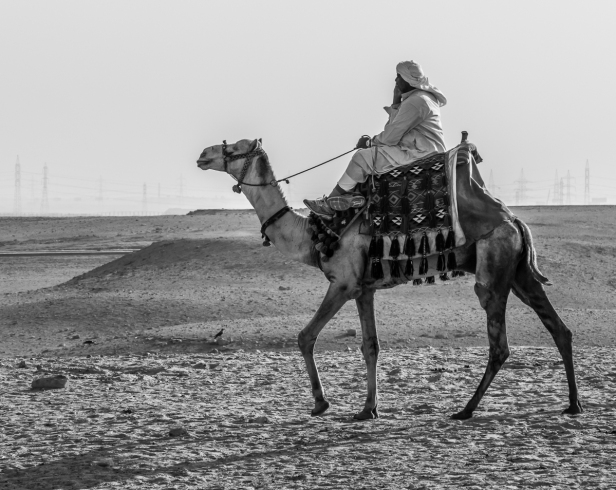
11-12 October 2015. A wave of fear washes over me. I’m bent double, surrounded by stone – floor, walls, and ceiling. I’m in an upward sloping dimly lit passage that’s barely wider than my body, and suddenly I’m afraid. I can’t specify what I’m afraid of except the fact of being confined in this dim cold space with no end in sight. I continue putting one foot in front of the other, following the person in front of me, my head almost level with my knees. The passage is mercifully short and the fear passes almost as quickly as it comes. Within a couple of minutes we break free into a high corridor several feet wide and many stories high. Now we are walking steadily upwards on a narrow wooden path in the middle of the passageway. We can barely see the top of the sloping walls.

We are in the Grand Gallery, a monumental hallway forty-seven metres long that ends at another very short shaft. Again we must bend double, but the shaft is only about two metres long and we can see the end of it before we even enter. We pass through it and enter into a dimly lit rectangular stone room built from red granite. It is not large, being only about ten metres by five, with a height of six metres; it’s big enough to walk around in, but not big enough to get lost in. Towards one end there’s a stone platform, an ancient sarcophagus. That’s it. Nothing remarkable at all.
What is remarkable is where we are. We are in the King’s Chamber, the burial chamber of King Khufu (Cheops) deep in the centre of the Great Pyramid on the Plains of Giza. It’s a heart stopping moment for me. I think I scream a little. I can’t believe where I am. It has been a dream of mine for fifty years to see the pyramids, but to be inside of one, right in the heart of it, surrounded by the perfectly cut stones that form it, is almost more than the mind can comprehend. I am in Egypt! Deep inside the Great Pyramid! I am ridiculously excited.
We’d arrived in Cairo the day before, late in the afternoon, met with our tour guide, and had dinner at the hotel with another couple from the group. It’s the first full day of the tour, and it begins with a drive through Cairo’s smog and crushing traffic to the Egyptian Museum. The drive gives us our first glimpse of the pyramids. Involuntarily my eyes widen and I’m immediately excited. I can’t believe I’m actually here.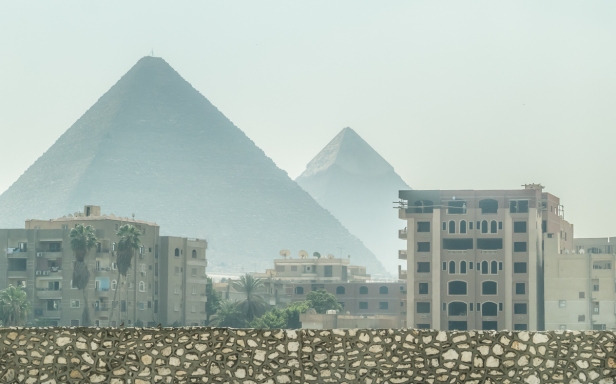
The garden courtyard of the museum is filled with ancient statues; mute custodians of a great civilization that lasted for over four thousand years, and that we are still trying to piece together and understand today.

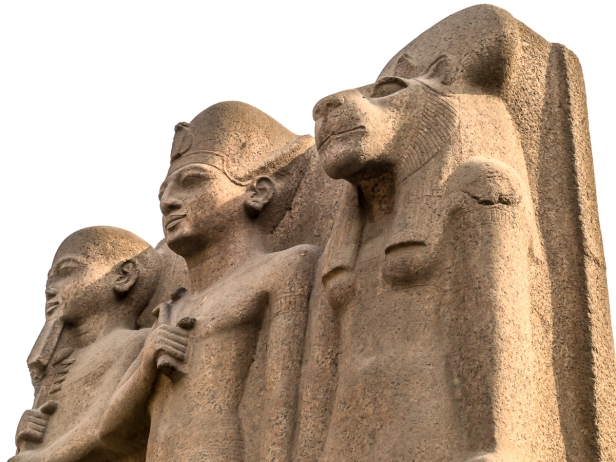
Inside, where photography is not permitted, the museum is crammed with more than 100,000 items, a breathtaking assemblage of Egyptian antiquities and one of the world’s most important collections. The original functional layout of the museum was lost with the discoveries of the treasures of Tutankhamun, and of the Royal City of Tanis. These artifacts were squeezed in, so that wandering the vast museum feels like a dim, dusty and crowded walk back through the millennia. There are one hundred and seven halls filled with artifacts from prehistoric times to the end of the pharaonic era: endless hallways of grand statues and glass enclosed cases. We see grave goods, luxurious jewellery, eating bowls and utensils, shoes, carvings, sculptures, ceramics, and toys of people who lived thousands of years ago. A monumental statue of Thutmose III, sits next to a tall glass-fronted case filled with smaller pieces. I gaze incredulous at the mummies of pharaohs I’d learned about fifty years earlier in high school, noting their skin, their hair, their fingernails, and their dried shrunken bodies. It’s an enormous amount to take in, and I am glad of our guide who tells us stories of those kings, queens, concubines, and power brokers of long ago as we follow her down the long hallways to the most interesting pieces.
The crowning glory of the museum is, of course, the treasures of Tutankhamun, a boy crowned king nearly three thousand years ago at the age of nine and mysteriously dead only nine years later. The wealth of his tomb, which now resides in the museum, is almost unimaginable. Some three thousand separate objects were found, many of which are solid gold. There are gold-covered thrones and furniture, six dismantled chariots, jars of precious oils and ointments, jars of food, and thirty jars of wine. There are gold covered shrines and gilded statues, model boats, daggers, shields and other weapons, musical instruments, lamps, ornaments, walking sticks, ostrich fans, piles of precious jewellery, clothing of the finest linen, shoes and socks, and the four canopic jars that housed the internal organs of the king. There is everything that Tutankhamun could possibly need for the afterlife. We say “you can’t take it with you”, but apparently the Egyptians of antiquity believed that you could.
And of course there are the most famous pieces of all: Tutankhamun’s solid gold Death Mask weighing eleven kilograms (24 pounds) and his three coffins, including the extraordinary solid gold coffin. I think that bears repeating: solid gold coffin. Can you imagine? Not only is it solid gold, like the mask it is intricately and beautifully decorated with engraving and inlaid precious stones. It is exquisite in its regal splendor. And then there’s another coffin, and another, that stack one inside the next like Russian dolls.
Listen to this: King Tut’s mummy had a solid gold Death Mask placed upon it. It was then placed in a solid gold coffin, which was placed in a gilded wooden coffin, which was placed in another gilded wooden coffin, which was placed in a granite sarcophagus, which was placed in a gilded shrine, and then in another gilded shrine, and then in a third gilded shrine, which was covered in a linen pall draped over a frame, all of which was placed in the outer-most gilded shrine. Can you imagine? The body was encased in nine layers of coffins and shrines, each bigger than the last! Every piece is on display in the museum, breathtaking and barely comprehensible.
And for all that, I think one of the most astonishing pieces I see, because it is so completely unexpected, is Tutankhamun’s underwear: a triangular linen cloth that looks very much like an old-fashioned diaper.
Three pyramids were constructed on the west bank of the Nile between 2575 and 2465 BCE. They were built as burial monuments for three Egyptian kings: Menkaure, Khafre (Khefren) and Khufu (Cheops). They were covered in smooth limestone and glowed in the sun. They were royal, revered places dominating the Plains of Giza, far from the city. Insistent, unassailable, undeniable, sacred.
It is still the same. For all that the tombs have been breached and probably robbed, that the city of Cairo has almost enveloped them, that the place is brimming with tourists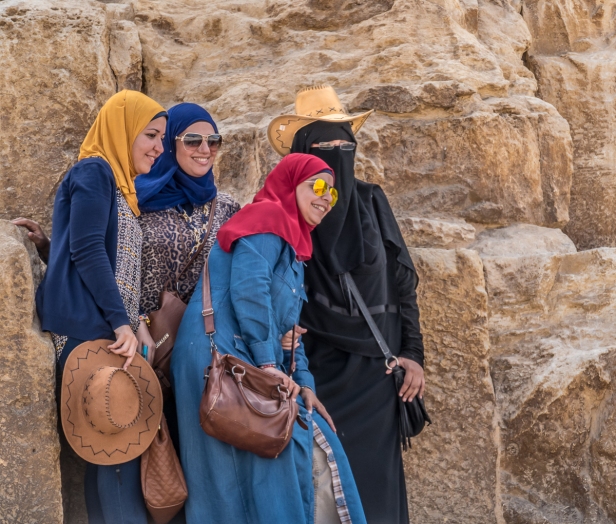
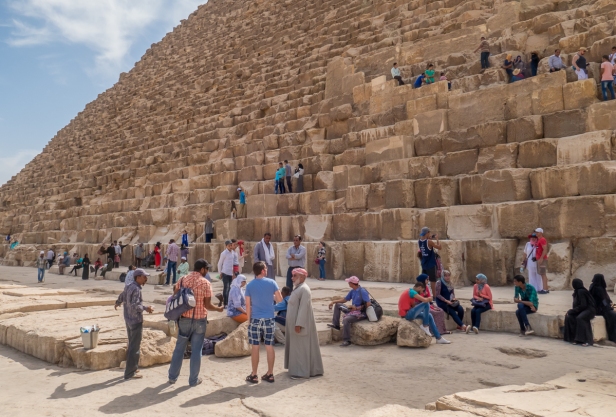
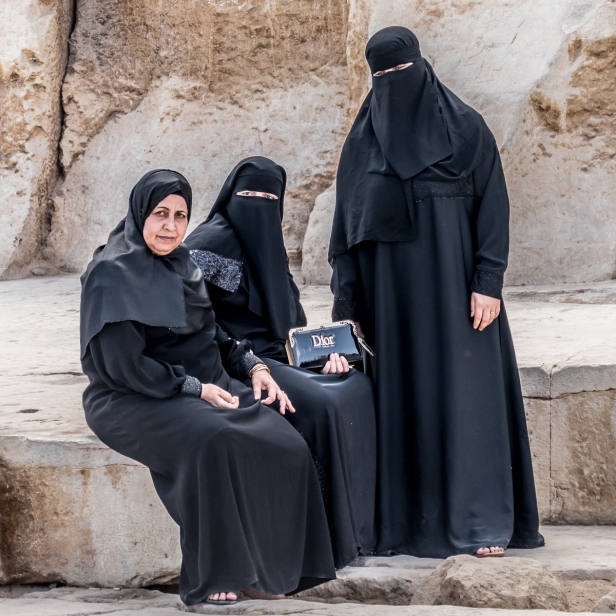
and with the men of the area offering horse-and-buggy or camel rides,
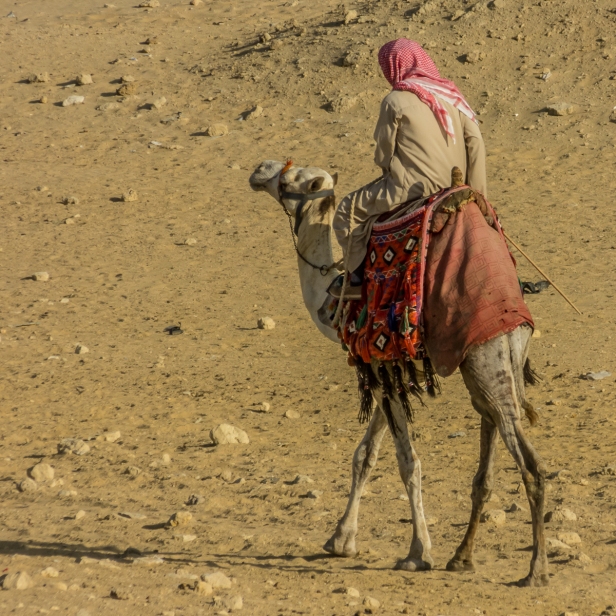

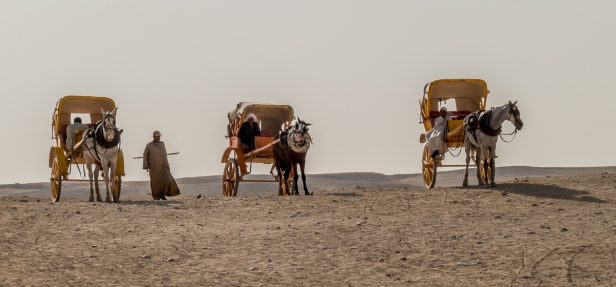


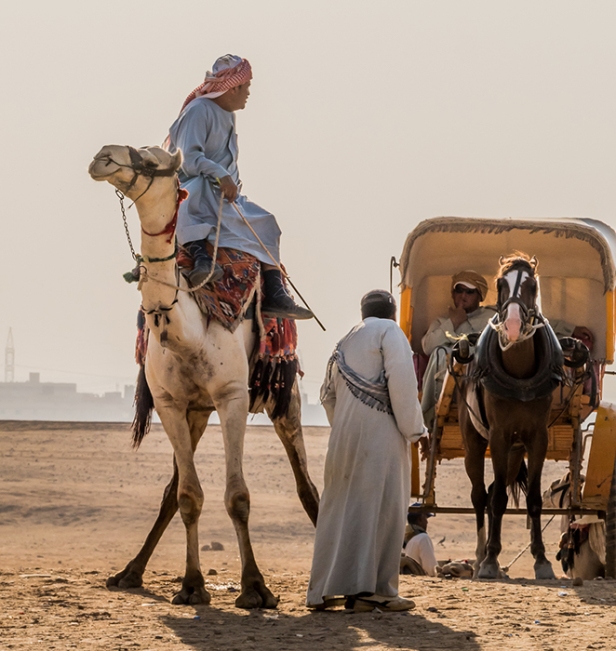
the pyramids still inspire awe. There is nothing in the world like them.
Arab proverb: Man fears time. Time fears the pyramids.
Approximately 2.3 million blocks of stone were cut and assembled to create the Great Pyramid of Khufu. It is an almost unimaginable feat. And that is for only one of the pyramids. There are two more of monumental size standing next to it, and several smaller pyramids throughout Egypt.
The pyramids are an enigma. The Arabs were the first to discover the way inside the Great Pyramid and it is said that they found nothing there, however we now know there are many narrow shafts winding throughout the interior with doors and more doors behind them. The king’s body has never been found. It could still be in there in some inner chamber that has yet to be discovered, or it could have, according to Arabic lore, been found with enormous riches centuries ago. It is not known if the Great Pyramid was actually built as a tomb, or as a storehouse for ancient wisdom, or as an energy accumulator, or as a map of the future of mankind. The tunnels have been explored by robot and seem to end in mysterious miniature doors. These discoveries lead to speculation that the pyramid has further secrets. Exploration is ongoing.
Housed in a new purpose-built structure, close by the pyramids on the Plains of Giza, is a huge trench that is still partially covered with enormous slabs of stone.
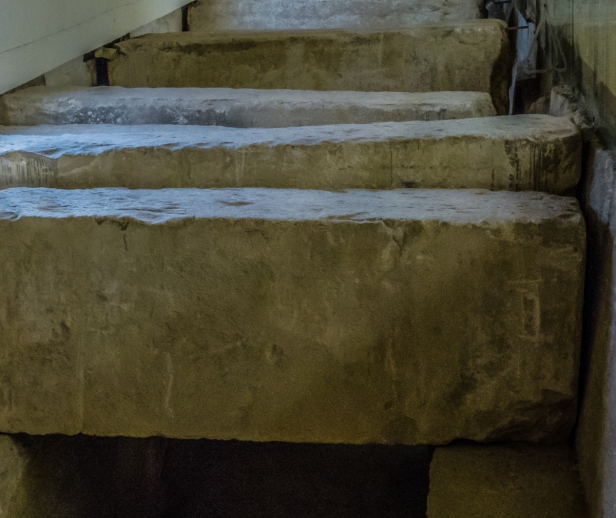
The trench is long and deep, and when first found the top was covered with forty-one slabs of stone, each weighing sixteen tons, each weighing 160 thousand kilograms! Forty-one of them lay side-by-side forming a lid on the trench. How did they ever move them into place?
Inside the trench was a dismantled boat, forty-two metres (138 ft) long.
This graceful boat was made from cedar imported from Lebanon 4500 years ago, and every one of the 1224 pieces of wood was joined by ropes.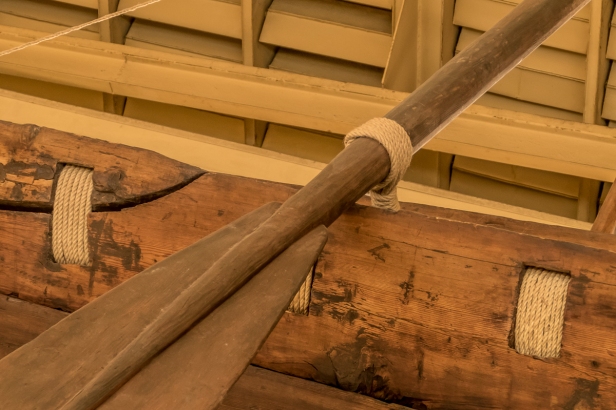
Archeologists found five trenches, and five boats, all of them dismantled. The one we looked at has been painstakingly pieced together like a huge 3D jigsaw puzzle. It was an astounding feat to build it, and an equally astounding feat to piece it back together 4500 years later. It was Khufu’s boat and he needed to have it with him for the afterlife.
It’s getting late in the day. We arrive at the Sphinx towards sunset. It’s no longer possible to walk up to it. There are fences, and locked gates, and a whole huge platform with seating for the reputedly hokey evening sound and light show. Our fearless guide convinces the guards to let us in at least part way. The unmistakable ineffable monument glows golden in the late afternoon sun.
The Sphinx is the largest monolith statue in the world. It stands 73 metres long, 19 metres wide, and 20 metres high. My photograph does not reveal how enormous it is. To put it in perspective, the length is equal to that of a twenty-four-story building, and the height equal to a ten-story building. It is truly colossal. It is thought to be a portrait of King Khafre, or perhaps of his father Khufu. The Egyptians built such statues, with the head of a human and the haunches of a lion, as guards of important areas such as tombs and temples.
Greek legend: The Sphinx would devour all travellers who could not solve it’s riddle. What walks on four legs in the morning, two legs at noon, and three in the evening? The hero Oedipus gave the correct answer causing the Sphinx’s death. Man walks on four legs in the morning (when crawling as a baby), two legs at noon (as a child and adult throughout life), and three legs in the evening (two legs and a walking stick in old age).
We finally leave the area to have dinner at a nearby restaurant, and get to see something of the sound and light show through the window.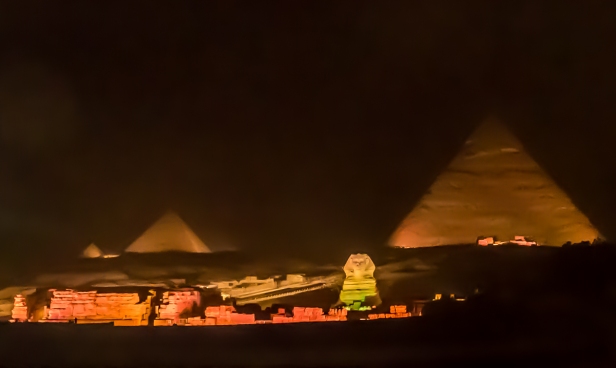
Some time later I was able to return to view the Sphinx on a rare clear day, and walk up closer to it. Its power is unmistakable.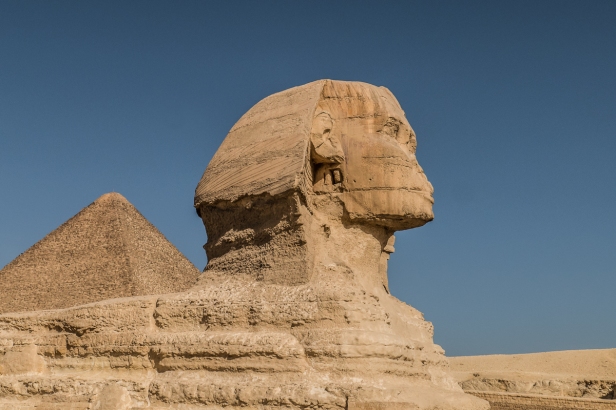
And so ends the first full, very full, day of our tour through Egypt. The more I learn about ancient Egypt the more I realize how little we know for sure. When I was in high school I was invited to take honors-level art. This meant that I could specialize in art history. I was obliged to study modern painting, sculpture, and architecture. Beyond that I could choose whatever period of history I liked. I chose pre-Christian art. The reason? I was fascinated to know how we know what we know about the events of thousands of years ago just from a few shards of pottery, a few half-destroyed paintings, and some old ruins. It fascinates me to this day. For all the expertise of archaeologists it still feels to me as though it’s all a huge concoction guessed from random tantalizing clues; a folktale that could as easily be true as not. The head of the Sphinx is Khufu or Khafre? What do we know for sure about the inside of the Great Pyramid? And what was its real purpose? The more I read the more it seems that we really know very little, and even though it is frequently literally written in stone our understanding and interpretation of it really aren’t.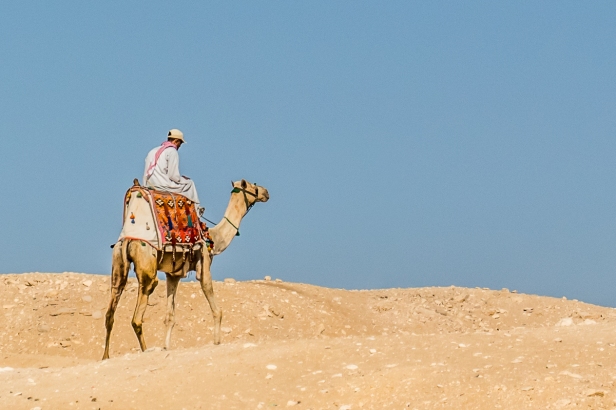
Next post: Alexandria and Aswan
All words and images by Alison Louise Armstrong unless otherwise noted
© Alison Louise Armstrong and Adventures in Wonderland – a pilgrimage of the heart, 2010-2016.

I have never visited Egypt or the pyramids, but I thought I knew a lot about them, but you have taught me quite a bit more. Thank you!
LikeLiked by 1 person
Oh thank you! I find them very fascinating. I hope you get to go there one day. It’s really quite extraordinary.
Alison
LikeLiked by 1 person
Thank you! I hope so too. It is definitely one of the places on my bucket list.
LikeLiked by 1 person
Alison! I can feel your excitement in your words and the way your descriptions of this entire day are dripping with detail and enthusiasm. What a fascinating post, thanks to your passion for this place. Awesome that you got closer to the Sphinx! Incredible photo, as is every single one shown here. Just beautiful. Can’t wait to go here someday. (And we’re off to Cuba tomorrow! Hooray!) 🙂
LikeLiked by 1 person
Thanks Kelly. It was incredibly exciting! I still can’t believe I was actually there. Cuba! How fabulous. Can’t wait to hear all about it. We’re planning to go this winter. We were visiting a friend the other night and she had a pile of books at her front door waiting to be delivered to a thrift store. Two books on Cuba in the pile! So I now have a little reading to do. Have a fabulous time. When do you get back? – it’s time we got together for brunch.
Alison
LikeLiked by 1 person
We get back on the 27th. Let’s shoot for brunch sometime in August — somewhere quiet and delicious!! Have fun reading up on Cuba! See you soon! Hello to Don! 🙂
LikeLiked by 1 person
Yes, August sounds good.
A.
LikeLiked by 1 person
What an article!!! Loved every word. It has been my dream to visit the pyramids but somehow I haven’t been able to manage it. But I had a great journey through your words… 🙂
LikeLiked by 1 person
Thanks Aishwarya. I had fun putting this one together. It’s a most fascinating place! I’m glad you enjoyed travelling to Egypt with us.
Alison
LikeLiked by 1 person
Like you I am fascinated by this Ancient Civilisation. I have been to Egypt, but only to go scuba diving in the Red Sea and I also visited the Sinai. To visit the pyramids would be a dream come true. I loved this post and your passionate descriptions. Was your guide part of a tour package? How many days would you recommend to stay there? I can’t wait for your next post.
LikeLiked by 1 person
Thanks Gilda. Egypt was a lifelong dream for me, and amazing! Our guide was part of the tour. It’s one of the advantages of a tour that I forgot to mention in the post I wrote about group travel – you get a built-in tour guide. She was an excellent guide. I know that if we’d been travelling independently we would probably have booked ourselves a week in Cairo as we usually do that for big cities. As it was we had three days and it felt like enough. The tour was eleven full days. It was certainly enough for highlights but not enough to really explore Egypt. Not sure I’d want to do that anyway these days. It’s probably okay, but going too far from the main tourist areas maybe a bit risky.
Alison
LikeLike
I felt quite breathless with excitement readiing this post, Alison. Such wonderful photos and descriptions and I learnt so much. Thank you so much.
LikeLiked by 1 person
Thanks so much Ros. I’m glad my excitement was contagious! It was a really amazing experience.
Alison
LikeLike
“mute custodians of a great civilization” I like that, that’s exactly how it feels, beautiful x
LikeLiked by 1 person
Thank you so much AFAH. The sense of timelessness around Egyptian antiquities is very powerful. There’s a depth that’s impossible to ignore. It’s as if they’re trying to speak to you, but do it with profound stillness.
Alison
LikeLiked by 1 person
Your opening was a perfect description of claustrophobia and I can so feel your excitement: Egypt! The Pyramids! Mummies and treasures! The Sphinx! And in fact, the museum itself sounds claustrophobic crammed with all the thousands of treasures to examine and wonder about. (The underwear/diaper lends a surprisingly down to earth element amidst the grandeur.) Loved this post, Alison. 🙂 Anita
LikeLiked by 1 person
Thanks Anita. This whole day was a travel highlight that’s for sure. All Egypt was. I’m still excited about it. The museum was overwhelming. I think it was the only part of the tour that I’d have liked more time. We both get museum overload. We can only take in so much at a time. I think we had about three hours there and we felt saturated, but it’s one of those museums that definitely deserves more than one visit. Two at least, and maybe more than that. Most of the world’s great museums are like this I think.
Ha, the underwear! It was the very last thing I expected, but I love these little details of ordinariness.
Alison
LikeLike
WOW. This was an incredible post!! I loved the photo of the pyramids in the distance behind the city- you can get a sense of how titanic they are, looming above all else! We can’t wait to go someday. Thank you for this.
LikeLiked by 1 person
Thank you so much! I’m glad you enjoyed it. I had a lot of fun putting it together. The pyramids really are something quite extraordinary. Beyond words really. I hope you get to go one day.
Alison
LikeLike
Another wonderful post that enables me to travel along with you. There is such magnificent history here. I especially loved the photo with the camel and pyramids behind it.
LikeLiked by 1 person
Thanks Angeline. It’s an amazing place. The history, that whole civilization, is really mind-blowing. That photo is my favourite too. And Sue’s. And Darlene’s. We all have excellent taste 🙂
Alison
LikeLiked by 1 person
Your article is fascinating and a very enjoyable read. I’m glad you got to live your dream, Alison, and I’d be claustrophobic too in those cramped spaces! I love your description of the seven intricate layers of Tutankhamun’s sarcophagi. And I agree – the past is a mystery and very often concocted from seemingly random clues. Thank you, Alison and Don.
LikeLiked by 1 person
Thanks IsabellaRose. Thank goodness the claustrophobia didn’t last. It was just a brief flash and then it was gone. I’ve just read something new about Tut’s coffin/shrine set-up. Apparently it was nine layers! I must go in and correct it.
I love how archaeologists piece things together, both literally and figuratively, but that in the end it may not be right at all.
Alison
LikeLiked by 1 person
Fascinating. It just proves once again, the more we know, the more we know we don’t know, and much of what we think we know is conjecture. One wonders if someone from that era saw today’s mysteries, would they be as fascinated as we are in theirs, or just shocked?
LikeLiked by 1 person
Thanks Dave. I find ancient history fascinating precisely because it’s all conjecture. It’s like reading a tale, and I’m also fascinated by myth and legend for the same reason – they’re presented as tales, but could just as easily be true.
I think they’d be both fascinated *and* shocked!
Alison
LikeLiked by 1 person
We have not been to Egypt and your photos and description definitely have me pondering. What a thrill it must be to see these giants. The photo of the camel with the backdrop of the pyramids is stunning!
LikeLiked by 1 person
Thanks Sue. Your favourite photo seems to be the fave of many, me included.
It was unbelievable to finally be in Egypt. Not enough superlatives. Go if you can. There’s really no describing what the pyramids are like – the sheer size of them, and the puzzle over the purpose of the Great Pyramid, and how they ever built them. I was completely in awe.
Alison
LikeLike
One of my dreams is to visit the pyramids as well. The pictures are fascinating. My favourite is the one of the camel with the pyramids in the background. I now see Sue has picked the same one as her favourite!! What an amazing day you had. One you will never forget.
LikeLiked by 1 person
Thanks Darlene. I hope you get to the pyramids. It’s an extraordinary experience, and will always remain a travel highlight. We all have the same favourite photo!
Alison
LikeLike
Sadly I realized how little I knew about the pyramids until I read your post. I have always yearned to visit Egypt but I’m not sure I can convince my hubby. Your images are wonderful.
LikeLiked by 1 person
Thanks LuAnn. Egypt is one of the highlights of all our travels. I knew a bit about it thanks to all those high school years studying pre-Christian art, and learned more when I was there and then through putting this post together. It was a dream of mine to go there since high school. I plan on writing several more posts about this extraordinary land. Maybe it will help convince your hubby 🙂
Alison
LikeLiked by 1 person
What a great commentary of your experience. Can you please advise the name of the guide you used – would you recommend the company? We are planning to visit Egypt and would like to book with a reputable company there.
LikeLiked by 1 person
Thank you so much. We did a 12 day tour with Intrepid, and our guide’s name was Hoda, though she may no longer be with them. She is worth asking for! Everything about the tour was excellent.
Alison
LikeLike
Thanks for getting back so quickly. We (Wayne & Melody) are from Perth West Australia and love your travel blogs. Spent 8 weeks in British Columbia, Alaska, Montana last autumn and very much enjoyed your city of Vancouver. Spent most of our time walking in the stunning National Parks.
LikeLiked by 1 person
Alison, when I stood underneath the Eiffel Tower for the first time I was so excited and thought how a landmark I learned at school was in fact right above me. So I can imagine when one day I stand inside the pyramid I will be as excited as you! The more we learn about the history of the world the more we realize we only know a little — those who don’t bother learning seem to be the ones who think they know best of everything.
I love your photos, Alison, especially the ones with clear, blue skies. Such a magnificent view!
LikeLiked by 1 person
Thanks Bama. Oh yes, I know just how you felt standing under the Eiffel Tower – the same feeling of excitement. I had it over and over in Egypt.
I often have the feeling that the more I know the more I realize how little I know for sure. Nothing seems written in stone to me, even the stuff that’s written in stone! 🙂
I was so glad that I was able to go back to the pyramids on a clear day.
Alison
LikeLike
What a phenomenal and remarkable experience. Thank you for bringing this alive!!
LikeLiked by 1 person
Thanks Carissa. It was an amazing experience! I could hardly believe where I was, that I finally got to the pyramids, and then I got to go inside one of them! It really was incredible.
Alison
LikeLiked by 1 person
Your sense of awe and wonder came across very clearly! 🙂
LikeLiked by 1 person
I’m so glad you lived this experience. What a description! What photos! 🙂
LikeLiked by 1 person
Thanks Susan. It was an amazing experience, a life long dream. All Egypt was one of the best of all our travels.
Alison
LikeLiked by 1 person
Amazing photos!
LikeLiked by 1 person
Thanks s much Jun. I actually must give credit to my sister Suzanne for this lot – she helped me with cropping and they are much more powerful as a result.
Alison
LikeLike
Alright, Alison, I am officially jealous. I share you enthusiasm for ancient Egypt. Both your words and photos brought it to life in this blog. Great job of capturing the mystery as well as the beauty. Thank you. –Curt
LikeLiked by 1 person
Thanks Curt. I’d be jealous of me too 🙂
I can’t believe I finally got to Egypt. It has been a dream of mine for so long. I’ve been fascinated by ancient Egypt since high school. It’s the mystery that draws me in. There’s something so enigmatic about it all. I don’t think we know even half of the truth of what that civilization was about. I’d love to go back and explore more, but it’s unlikely we will – that part of the world seems to get more unstable by the day.
Alison
LikeLike
That and ancient Greece, more so than ancient Rome. And it is so sad, tragic actually, what is happening in the Mid-East. I could go on quite a while about that. –Curt
LikeLiked by 1 person
Yeah me too, but I prefer to keep mu sanity.
A.
LikeLiked by 1 person
The pyramids are on my bucket list (of course) but I am not sure I could crawl through small passageways. I do understand how you feel about knowing very little about ancient history: when I was up at Hadrian’s Wall last summer, I realized just how much we don’t *know* about the Romans, and they’re the foundation of Western civilization! For instance, it wasn’t until a few years ago that they were able to find proof that women could write. Archeologists had *supposed* they must be able to, but it took ages to find proof of a woman’s handwriting.
LikeLiked by 1 person
Oh I do hope you get there Felicity. It really is amazing. And yes I feel a bit the same way about all the pre-Christian civilizations – how do we really ever know for sure what they were like? I’m so glad to hear they discovered proof that women could write too!
Alison
LikeLike
What a great post on this enigmatic place. I loved the hazy photos of the pyramids from the city and, of course, the sphinx, but your excitement and awe are what really shine through the post.
I am drawn to the pyramids’ grandeur and mysteries like you, and I can’t wait to see them myself some day. One of the clearest memories of my childhood was a trip to Washington, DC, to see the King Tut exhibit when it first came to the U.S. My parents herded four of us kids on the national mall as part of an 8-hour line to enter the museum; after hours of griping and moaning about the heat and the wait, every one of us was transfixed by the exhibit. I’ll never forget it, and the topper would be a chance to see many of those items again in their real home!
LikeLiked by 1 person
Thanks lexklein. I was most definitely excited and in awe!
What a childhood experience! An eight-hour wait must have seemed interminable as a child. I’m delighted to hear that it was worth it. I bet it fuelled (in a more or less subtle way) future travel. I hope you do get to Egypt one day. It’s an extraordinary country.
Alison
LikeLiked by 1 person
Alison i was absolutely fascinated reading your post – i learned so much and felt your excitement – got chills a couple times! You have brosdened my horizons and i thank you for taking the time to make it all come alive for me – no one else has done that as well as you! Just eating it up! Hugs, Jo
LikeLiked by 1 person
Thanks so much Jo Ann. This was one of those easy posts to write, where I’m so excited about a place that the words just flow. I’m glad they conveyed how incredible it was for me, and that they brought it alive for you.
Alison
LikeLike
Stunning photos! Thank you for lesson about Egypt.
LikeLiked by 1 person
Thanks so much Bill, and my pleasure! I love sharing about our travels. And thanks for following. I hope you enjoy further tales of our travels.
Alison
LikeLiked by 1 person
You’re welcome! I hope you both enjoy the rest of your travels. Bill.
LikeLiked by 1 person
My heart skips a beat when I read your posts and see your photos. Thank you for sharing it all with us.
LikeLiked by 1 person
Thanks Carol. I can tell you my heart was skipping beats when I was there. It was a truly amazing experience.
Alison
LikeLike
Awesome photos and commentary as always. A wonderful experience for us who travel virtually through you. Thanks again.
LikeLiked by 1 person
Thanks so much Eileen. Happy to share it – it was an amazing experience. All Egypt was an amazing experience!
Alison
LikeLike
Beautiful photographs. I particularly like the close up of the blocks of the pyramid and the wonen in black with the gucci clutch.
have wanted to visit Egypt for some time and your post certainly reinforces that desire. I’m sure we will get there one day. It looks as fascinating as I imagine it to be.
Peta
LikeLiked by 1 person
Thanks so much Peta. I loved the Saudi women with the Gucci bag – such a weird juxtaposition. I hope you get to Egypt. It really is extraordinary.
Alison
LikeLike
I’d always wanted to go one day, too. 🙂 The boats were unexpected.
LikeLiked by 1 person
The boats were completely unexpected, and fascinating. Hope you get there!
Alison
LikeLiked by 1 person
As many have said, a great post, Alison. It is easy to overlook the way your writing carries us along, (which makes it very good!), but you have a lovely way of bringing us right up close to witness your discoveries with you.
I love that we humans don’t even understand the mystery of other humans. There is something exciting about that for me. So much is known, and yet… these things we ourselves have done remain enigmatic. That the pyramids could have sat quietly upon the desert for thousands of years and still contain unexplored passageways is truly a delicious thought, since we’ve mapped the whole surface of the Earth practically with satellite but have yet to fully solve this ancient riddle of hide and seek! And part of you feels like the real mysteries there are perhaps invisible entirely!
I looked up some pictures of the Sphinx that had people in them and it really put the size into perspective. Stunning…
Peace
Michael
LikeLiked by 1 person
Thanks Michael. I love these kinds of posts that are easy for me to write because I’ve been so moved by the experience. And it’s wonderful to hear that people reading get swept up in it too. That is my aim.
The pyramids blow me away. That they, as you say, have sat quietly for thousands of years and still are not fully known or understood is astonishing, and wonderfully enticing to me. What will they discover next?! And how will they explain it? It’s the explanations that get me. They seem so inventive!
I do most certainly feel that the real mysteries are invisible, at least to our eyes in “ordinary” reality. I’ve seen through it on more than one occasion, and then wonder at the invisible mystery beyond that!
Alison
LikeLiked by 1 person
Beautifully written Alison, as always… I could feel your excitement… how I wish to be there too someday! Loved the photos 🙂
LikeLiked by 1 person
Thanks Pelly. I was sooo excited to be there – the dream of a lifetime come true. I hope you get there. It’s really amazing.
Alison
LikeLiked by 1 person
Oh my gosh what a fascinating post-your words and images do a wonderful job of sweeping the reader between past and present. I look forward to reading more on your blog-Thank you!
LikeLiked by 1 person
Thanks so much Meg. It’s always wonderful to hear that people are swept along. It was such an exciting time for me. Thanks for following!
Alison
LikeLiked by 1 person
All of those carvings in stone are absolutely incredible.
Thanks for virtually taking me to Egypt….I’ve never been there before!
Oh…and…I understand your reaction to being in a tight space with no end in sight. Claustrophobia! I can deal with that feeling of fear, if I don’t have to stay with the “trapped” feeling for too long. 🙂
LikeLiked by 1 person
The museum is *packed* with stone carvings from the ancient Egyptians, so many it’s impossible to take them all in – unless you’re a scholar or something.
I’m not usually claustrophobic, so it was a bit of a surprise, but it was very brief thank goodness.
Egypt is truly amazing. I’m glad you enjoyed this little glimpse. There will be anymore posts to come.
Alison
LikeLike
Congrats on the Discover interview – very cool. I have been in Alaska all summer with almost no internet but I’m looking forward to getting caught up on your posts.
You did a great job capturing the pyramids in photos, with the variety of shots. I really like the ladies with Dior bag. Nice catch.
LikeLiked by 1 person
Thanks Jeff. I loved the Pyramids – definitely a highlight for me. I thought the Dior bag was a lovely touch. Those women are almost certainly Saudi – very wealthy.
Alison
LikeLike
Lovely photos, especially of the locals. I really loved Egypt when I was there and hope to go back one day. The museum is really something, isn’t it?
LikeLiked by 1 person
Thanks Emily. We also loved Egypt. What an amazing country, with so much history. And yes, the museum is really something!
Alison
LikeLiked by 1 person
Love the human element in this post as much as the pyramids. Isn’t the solar barge magnificent? And king Tut’s mask! Thank you for the opportunity to revisit some special memories 🙂
LikeLiked by 1 person
Thanks Madhu. It was so wonderful for me to finally get there. And then to see King Tut’s mask and coffin, and then the boat that I’d never even heard of! It was all pretty exciting.
Alison
LikeLike
Alison, yeah…you were right, I did enjoy this one immensely. However, I’m a bit bummed. Because I did not get a good shot of the sphinx. For some reason, I just couldn’t get the right angle or something. And for some other reason, we didn’t go to the place where that boat was. The photo of the camel in front of the pyramid is outrageously Nat Geo-ish.
LikeLiked by 1 person
Thanks BF. I’ve just reread this post and realize that I need to drum up a bit more excitement for the post I’m about to publish about a couple of temples we visited. I was lucky to get a clear day for the sphinx, and managed to get closer to it than the previous visit. I’d love to go right up in front of it but you can’t any more. That’s one of the disadvantages of travelling now instead of 40 years ago when I was still young. I wandered around Stonehenge before they put the fence up. Pretty amazing though I think I’d appreciate it more now. I was quite pleased with the camel in front of the pyramids shot too 🙂
Alison
LikeLiked by 1 person
Exactly…last time I went to Stonehenge, the fence was up. We didn’t even go inside, it was so disappointing and full of people. It was very cool in the 60’s to just sit with your back against a stone and feel…whatever that was!
LikeLiked by 1 person
this is worthy in our bucket list! we especially like the people photos and of course the pyramids! so beautiful 🙂
Thanks a lot for sharing this Alison and Don! 🙂 Hope we can visit soon!
LikeLiked by 1 person
Thanks so much. Hope you get to the pyramids! Egypt really is an amazing country. We had a great time there.
Alison
LikeLike
Wow, nice post. Thanks for sharing. Pyramids and Sphinx best tourism place in Egypt. Egypt is famous for its ancient civilization and houses some of the most magnificent images from all around the world including the Pyramids and Giza, the ancient temple of Luxor and the Great Sphinx. I visited Egypt last year with my family through a well known travel agency ask-Aladdin. Really the trip was fully adventurous for me. All the destinations are beautiful there.
LikeLiked by 1 person
Thanks so much Angela. We too enjoyed Egypt very much. I agree – all the destinations are beautiful there. It was one of the best trips we’ve done.
Alison
LikeLike